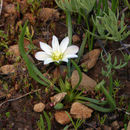Comments
provided by eFloras
Lewisia nevadensis represents one extreme of the
L. pygmaea complex (see discussion under 13.
L. pygmaea). Questionable geographic occurrences reflect plants that have one or more features otherwise suggestive of
L. pygmaea (e.g., more elongate roots, truncate and/or toothed sepals, and colored petals); such intermediates also occur in the range of "typical"
L. nevadensis (relatively robust plants with napiform roots, solitary flowers, acute sepals with entire margins, and white petals). Uncertainty respecting the affinity of specimens prevails in those from Arizona, Colorado, Idaho, and Wyoming. There are no supporting specimens from Wyoming.
B. L. Davidson (2000) noted that Lewisia nevadensis is a garden weed in Colorado; it is not clear whether or not these plants are escapes from cultivation.
The floral symmetry of Lewisia nevadensis may be somewhat elliptical, the two outer sepals and the remaining petals imbricate and opposite the sepals, giving the flowers a pinched appearance, a feature also reported for L. oppositifolia.
- license
- cc-by-nc-sa-3.0
- copyright
- Missouri Botanical Garden, 4344 Shaw Boulevard, St. Louis, MO, 63110 USA
Description
provided by eFloras
Taproots napiform to shortly fusiform. Stems suberect, becoming horizontal or deflexed after anthesis, base subterranean, 5-12 cm. Leaves: basal leaves withering at or soon after anthesis, gradually narrowed to broad petiole, blade narrowly linear to linear-oblanceolate, flattened, 4-15 cm, margins entire, apex obtuse to subacute; cauline leaves absent. Inflorescences usually with flowers borne singly, rarely 2-3-flowered in racemose cymes; bracts 2, opposite, linear-lanceolate, 6-18 mm, margins entire, apex acute. Flowers pedicellate, not disarticulate in fruit, 0.5-2 cm diam.; sepals 2, broadly ovate, 5-13 mm, herbaceous at anthesis, margins entire or with few shallow, nonglandular teeth, apex acute to subacute; petals 5-10, white or rarely pinkish, elliptic to oblanceolate, 10-15(-20) mm; stamens 6-15; stigmas 3-6; pedicel 10-40 mm. Capsules 5-10 mm. Seeds 20-50, 1.3 mm, shiny, muricate. 2n = 56.
- license
- cc-by-nc-sa-3.0
- copyright
- Missouri Botanical Garden, 4344 Shaw Boulevard, St. Louis, MO, 63110 USA
Distribution
provided by eFloras
Ariz., Calif., Colo., Idaho, Nev., N.Mex., Oreg., Utah, Wash.
- license
- cc-by-nc-sa-3.0
- copyright
- Missouri Botanical Garden, 4344 Shaw Boulevard, St. Louis, MO, 63110 USA
Flowering/Fruiting
provided by eFloras
Flowering late spring-late summer.
- license
- cc-by-nc-sa-3.0
- copyright
- Missouri Botanical Garden, 4344 Shaw Boulevard, St. Louis, MO, 63110 USA
Habitat
provided by eFloras
Wet grassy slopes and meadows near springs; 1300-3200m.
- license
- cc-by-nc-sa-3.0
- copyright
- Missouri Botanical Garden, 4344 Shaw Boulevard, St. Louis, MO, 63110 USA
Synonym
provided by eFloras
Calandrinia nevadensis A. Gray, Proc. Amer. Acad. Arts 8: 623. 1873; Claytonia grayana Kuntze; Lewisia bernardina Davidson; L. pygmaea (A. Gray) B. L. Robinson var. nevadensis (A. Gray) Fosberg; Oreobroma nevadense (A. Gray) Howell
- license
- cc-by-nc-sa-3.0
- copyright
- Missouri Botanical Garden, 4344 Shaw Boulevard, St. Louis, MO, 63110 USA
Comprehensive Description
provided by North American Flora
Oreobroma nevadense (A. Gray) Howell, Erythea 1: 33. 1893
Talinum pygmacum S. Wats Hot KiuK s Bxpt. 42. in part. 1871.
Calandrinia nepadcHsis A. Gray, Proc. Am. Acad. 8: 623. 1873.
Claylonia Grayfuna Kuntze, Rev. Gen. 57. 1891.
l^wisia nciadcni B l. Robinson, in A. Gray, 3yn. Fl. N. Am. I 1 : 268. IS'(7.
Acaulescent perennial, with a short flesh] taproot about 1 cm. thick ; basal leaves numerous, linear or linear-spatulate, 5-10 cm. long, 2-4 mm. widi i ipi Beveral, 5 I" cm. high, 1-3(usually 1-j flowered, often recurved in fruit; p d 1" low the middle; bracts land
linear, connate, scarious, i 1.5 cm. Ionx; -■ i' 'i ovate, acute, 7 10 mm long, entin ormiuutel] denticulate: i bite, elliptic, 12 15 mm long; stamens 6 I-'; stigmas 3 6; capsule
ovoid, 7 mm many, obliquely suborbicular, black, shining, muriculate, especiall}
along the margins, 1.3 mm. long.
Tyi-i: i.o, m.i i . Jandj placi East Humboldt Mi rada.
DnmuBUTiON Sand] puci olorado and northern California,
- bibliographic citation
- Percy Wilson, Per Axel Rydberg. 1932. CHENOPODIALES. North American flora. vol 21(4). New York Botanical Garden, New York, NY
Lewisia nevadensis
provided by wikipedia EN
Lewisia nevadensis is a species of flowering plant in the family Montiaceae known by the common name Nevada lewisia. It is native to much of the western United States, where it grows in moist mountain habitat, such as meadows. This is a small perennial herb growing from a taproot and caudex unit. It produces a basal rosette of several narrow, fingerlike to threadlike fleshy leaves up to 13 centimeters long. The inflorescence is a bundle of short stems a few centimeters tall each bearing a flower. The flower has 5 to 10 shiny white to pale pink petals each 1 to 2 centimeters long, pointed or with blunt tips. At the center are many stamens. This is sometimes grown as an ornamental plant suitable for alpine and rock gardens.[1]
References

- license
- cc-by-sa-3.0
- copyright
- Wikipedia authors and editors
Lewisia nevadensis: Brief Summary
provided by wikipedia EN
Lewisia nevadensis is a species of flowering plant in the family Montiaceae known by the common name Nevada lewisia. It is native to much of the western United States, where it grows in moist mountain habitat, such as meadows. This is a small perennial herb growing from a taproot and caudex unit. It produces a basal rosette of several narrow, fingerlike to threadlike fleshy leaves up to 13 centimeters long. The inflorescence is a bundle of short stems a few centimeters tall each bearing a flower. The flower has 5 to 10 shiny white to pale pink petals each 1 to 2 centimeters long, pointed or with blunt tips. At the center are many stamens. This is sometimes grown as an ornamental plant suitable for alpine and rock gardens.
- license
- cc-by-sa-3.0
- copyright
- Wikipedia authors and editors

